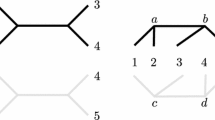Abstract
The tree constraint partitions a directed graph into node-disjoint trees. In many practical applications that involve such a partition, there exist side constraints specifying requirements on tree count, node degrees, or precedences and incomparabilities within node subsets. We present a generalisation of the tree constraint that incorporates such side constraints. The key point of our approach is to take partially into account the strong interactions between the tree partitioning problem and all the side constraints, in order to avoid thrashing during search. We describe filtering rules for this extended tree constraint and evaluate its effectiveness on three applications: the Hamiltonian path problem, the ordered disjoint paths problem, and the phylogenetic supertree problem.
Similar content being viewed by others
References
Aho, A., Sagiv, Y., Szymanski, T., & Ullman, J. D. (1981). Inferring a tree from lowest common ancestors with an application to the optimization of relational expressions. SIAM Journal of Computing, 10(3), 405–421.
Beldiceanu, N., Carlsson, M., & Rampon, J.-X. (2005). Global constraint catalog. Research Report T2005-08, Swedish Institute of Computer Science.
Beldiceanu, N., Flener, P., & Lorca, X. (2005). The tree constraint. In Proceedings of CP-AI-OR ’05, LNCS (Vol. 3524, pp. 64–78). Springer.
Beldiceanu, N., Flener, P., & Lorca, X. (2006). Combining tree partitioning, precedence, incomparability, and degree constraints, with an application to phylogenetic and ordered-path problems. Technical Report 2006-020, Department of Information Technology, Uppsala University, Sweden. Available at http://www.it.uu.se/research/publications/reports/2006-020/.
Beldiceanu, N., Flener, P., & Lorca, X. (2006). Partitionnement de graphes par des arbres sous contraintes de degré. In Deuxièmes Journées Francophones de Programmation par Contraintes (JFPC’06) (pp. 35–42). (in French).
Beldiceanu, N., & Lorca, X. (2007). Necessary condition for path partitioning constraints. In Proceedings of CP-AI-OR’07, LNCS (Vol. 4510, pp. 141–154). Springer.
Bininda-Emonds, O., Gittleman, J., & Steel, M. (2002). The (super)tree of life: Procedures, problems, and prospects. Annual Reviews of Ecological Systems, 33, 265–289.
Bodirsky, M., Duchier, D., Miehle, S., & Niehren, J. (2004). A new algorithm for normal dominance constraints. In Proceedings of SODA’04, (pp. 59–67).
Bodirsky, M., & Kutz, M. (2007). Determining the consistency of partial tree descriptions. Artificial Intelligence, 171, 185–196.
Bourreau, E. (1999). Traitement de contraintes sur les graphes en programmation par contraintes. Ph.D. thesis, University of Paris 13, France (March). In French.
Cambazard, H., & Bourreau, E. (2004). Conception d’une contrainte globale de chemin. In Proceedings of the Dixièmes Journées Nationales sur la Résolution Pratique de Problèmes NP-Complets (JNPC’04) (pp. 107–120). (in French).
Cayley, A. (1889). A theorem on trees. Quarterly Journal of Mathematics, 23, 376–378.
Cooper, K., Harvey, T., & Kennedy, K. (2001). A simple, fast dominance algorithm. Software Practice and Experience, 31(4), 1–10.
COSYTEC. (1997). CHIP Reference Manual, release 5.1 edition.
Dooms, G., Deville, Y., & Dupont, P. E. (2005). CP(Graph): Introducing a graph computation domain in constraint programming. In Proceedings of CP’05, LNCS (Vol. 3709, pp. 211–225).
Garey, M. R., & Johnson, D. S. (1978). Computers and Intractability: A Guide to the Theory of NP-Completeness. Freeman, New York.
Gent, I., Prosser, P., Smith, B., & Wei, W. (2003). Supertree construction with constraint programming. In Proceedings of CP’03, LNCS (Vol. 2833, pp. 837–841).
Katriel, I. (2006). Expected-case analysis for delayed filtering. In Proceedings of CP-AI-OR’06, LNCS (Vol. 3990, pp. 119–125). Springer-Verlag.
Kennedy, M., & Page, R. D. (2002). Seabird supertrees: Combining partial estimates of procellariiform phylogeny. The Auk, A Quarterly Journal of Ornithology, 119, 88–108.
Komlós, J., & Szemerédi, E. (1983). Limit distribution for the existence of a Hamilton cycle in a random graph. Discrete Mathematics, 43, 55–63.
Lengauer, T., & Tarjan, R. E. (1979). A fast algorithm for finding dominators in a flowgraph. ACM Transactions on Programming Languages and Systems, 1(1), 121–141.
Lorca, X. (2007). Contraintes de Partitionnement de Graphe. Ph.D. thesis, Université de Nantes, École des Mines, Nantes, France (in French).
Ng, M., & Wormald, N. (1996). Reconstruction of rooted trees from subtrees. Discrete Applied Mathematics, 69, 19–31.
Pape, C. L., Perron, L., Régin, J.-C., & Shaw, P. (2002). Robust and parallel solving of a network design problem. In Proceedings of CP’02, LNCS (Vol. 2470, pp. 633–648). Springer-Verlag.
Pósa, L. (1976). Hamiltonian circuits in random graphs. Discrete Mathematics, 14, 359–364.
Quesada, L. (2006). Solving Constrained Graph Problems Using Reachability Constraints Based on Transitive Closure and Dominators. Ph.D. thesis, Université catholique de Louvain, Louvain-la-Neuve, Belgium.
Régin, J.-C. (1994). A filtering algorithm for constraints of difference in CSP. In Proceedings of AAAI’94 (pp. 362–367).
Régin, J.-C. (1996). Generalized arc consistency for global cardinality constraint. In Proceedings of AAAI’96 (pp. 209–215).
Richaud, G., Lorca, X., & Jussien, N. (2007). A portable and efficient implementation of global constraints: The tree constraint case. In Abreu, S. & Costa, V. S. (eds.), Proceedings of CICLOPS’07, Porto, Portugal (September).
Schulte, C., Lagerkvist, M., & Tack, G. (2006). Gecode. Available at http://www.gecode.org/.
Steel, M. (1992). The complexity of reconstructing trees from qualitative characters and subtrees. Journal of Classification, 9, 91–116.
Tutte, W. T. (1946). On Hamiltonian circuits. Journal of the London Mathematical Society, 21, 98–101.
Author information
Authors and Affiliations
Corresponding author
Additional information
Some of this work was done while the second author was Visiting Faculty Member and Erasmus Exchange Teacher at Sabancı University in İstanbul, Turkey, during the academic year 2006/2007.
Rights and permissions
About this article
Cite this article
Beldiceanu, N., Flener, P. & Lorca, X. Combining Tree Partitioning, Precedence, and Incomparability Constraints. Constraints 13, 459–489 (2008). https://doi.org/10.1007/s10601-007-9040-x
Received:
Accepted:
Published:
Issue Date:
DOI: https://doi.org/10.1007/s10601-007-9040-x




